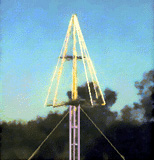#Lightning
If you are an experienced boater, it is quite possible that you once left the dock under fair skies and had to come back being chased by the Wrath of God… This column is about that.
Facts and Myths About Lightning
The only natural disaster that kills more Americans than lightning is floods. That’s right. Hurricanes, mudslides, forest fires and tornadoes all come in behind lightning. And what is amazing to me is that you can go to a NASA website, particularly given the intro above, (NASA-Lightning), and find that lightning avoids the ocean. This proves once again that there are lies, damn lies and statistics. Lightning may not hit the ocean often – the vast, almost limitless ocean that covers three-quarters of the surface of the planet – but it sure likes near-coastal environments… That’s where we are…!
We’ve all grown up counting to 5 or 6 between thunder claps to determine how far away the storm is and whether it is getting closer or not. Lightning, which can hit as far away as 20 miles from its source-thunder-cloud, is so dangerous that it just makes no sense to try to outwit it. That being the case, are there any preventative tools? Well, now that you ask, there is something called a Lightning Detector. They have been used by the military and aircraft operators for years. Now, for $200-$500, you can get a portable one for the boat.

“I need a lightning detector? I can see it!” Not if it is 20 miles away and you need to know if it is between you and home…
Unlike metal boats, fiberglass or wood boats, unfortunately, don’t conduct electricity well so “side flash” occurs, which makes the electric charge jump around looking for good conductors. Take a look in the mirror. We are good conductors.
What to Do…
Well, not getting hit in the first place is the best advice. If the weather forecast is bad, forget about trying to get out there to take advantage of the predators starting to “feed up” (they can sense the lowering pressure via their lateral lines) before the storm. It isn’t worth it.
But, if you are out there, what do you do when you see a storm approaching? NOAA says:
- Get out of the water if you are swimming off the transom. It's a great conductor of electricity.
- If caught in a boat, crouch down in the center away from metal hardware.
- Don't stand in puddles of water.
Let me add a couple of thoughts.
- Life jackets on everyone.
- Disconnect all electronics that aren’t essential to getting home. Electrical tape over the exposed leads so nothing climbs up the wire to the gear…
- If you can see the edges of the storm, and the center of the storm is between you and home, run at speed at a 90-degree angle to the storm and try to go around it. Squalls can be as deadly as a major blow but they are small’ish and can be avoided. If the storm covers the sky from horizon to horizon, see #4.
- Get on the radio and let the USCG know where you are, where you are headed and at what speed you can make. Check in every 15 minutes. After 30 minutes of not checking in, someone needs to start the “rescue starts now” clock...
- It would be great to have individuals aboard who are competent in cardiopulmonary resuscitation (CPR) and first aid. Many individuals struck by lightning or exposed to excessive electrical current can be saved with prompt and proper artificial respiration and/or CPR. There is no danger in touching persons after they have been struck by lightning. No joke. Some people fear that. No one has CPR training? Call the American Red Cross and get a course under your keel.
If a boat has been, or is suspected of having been, struck by lightning (overnight on a mooring?), check out the electrical system and the compasses to insure that no damage has occurred.
